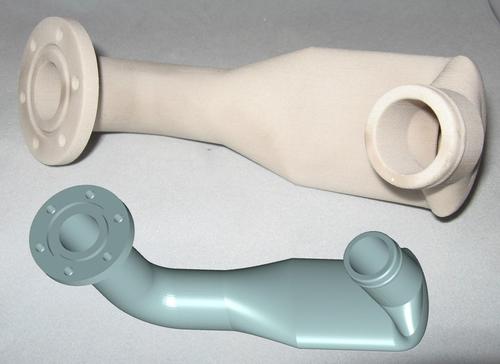Engineers Need to Think More Creatively
June 30, 2011

Lack of creative thinking by design engineers may be one of the hurdles facing the additive manufacturing industry.
That idea was floated by Sylvia Monsheimer, a German engineer, in a recent edition of the Evonik Science Newsletter. Monsheimer has skin in the game. She's business director of global market development for additive manufacturing at Evonik Industries.
"While a good, substantive idea for a new technology can come into being quite suddenly, it may still have difficulty reaching the heads of key players," she writes. "This is true in the case of additive manufacturing. Many universities teach the conditions for 'freedom of design' and 'function-driven design' inadequately, if at all."
She adds that engineers receive intensive training in conventional processes, but "they usually learn very little about freedom of design, which opens the door for them to additive manufacturing."
Additive manufacturing, invented in the United States in 1986, allows creation of three-dimensional parts, one tiny layer at a time, as a laser or print head moves over a bed of liquid photopolymers or powder materials.
It allows creation of designs that are no longer constrained by molds or other production tools that can limit the production of certain shapes of products. And some designs, such as those with curving internal channels, are virtually impossible with any conventional production system.
The issue that Monsheimer raises is only coming to the forefront now because additive manufacturing processes were initially used to make prototypes rapidly. The early materials used in additive manufacturing processes such as stereolithography were brittle or had other deficiencies.
New materials developments are now making it possible to use additive manufacturing processes to make parts in a variety of markets ranging from aircraft to medical implants. According to Monsheimer, an Airbus aircraft produced entirely through additive manufacturing would be 30 percent lighter and 60 percent more cost-effective than current models. The example, of course, is totally hypothetical because parts the size of fuselages and wings could not be made with currently available additive manufacturing technology.
One out-of-the-box design concept cited by Monsheimer is an intake manifold for the Evonik-sponsored Lotus racing car, which was produced by laser sintering from polyamide 12 powder. The geometry of the intake manifold is unique. It's a three-dimensional curved, elliptical tube. It could not be produced by conventional metal processing methods or by injection molding.

Evonik has developed special plastics for use in additive manufacturing processes. One is an ultra-flexible polyamide that has eight times the flexibility and five times the tensile strength of standard polyamide used for injection molding. High-heat polyetheretherketone (PEEK) has also been optimized for laser sintering.
Problems remain for extensive use of parts made with additive manufacturing processes -- even if engineers had totally open minds about design concepts.
The biggest is expense. Polyamides used for additive manufacturing typically can cost $90/kg to $130/kg, while polyamide for injection molding can be below $1/kg. "And that doesn't take into account all the scrap in the additive manufacturing process," industry expert Todd Grimm tells Design News. "Your effective usage rate can be 40 percent higher than the actual amount consumed in parts."
Waste in molding processes is reduced through use of hot runner systems that feed molten plastic into tool cavities. The high cost of materials for additive manufacturing reflects lack of scale as well as high development costs.
Another hurdle is lack of standards. Both the ISO (International Standards Organization) and ASTM, however, are working on developing the first standards for laser sintering. ISO 27547-1 is already on the books for the production of test samples. The ASTM Committee on additive manufacturing technologies is designated F-42. A new software file format is close to release.
"Despite the hurdles and unanswered questions that still exist, the importance of additive manufacturing will grow appreciably over the next ten years," writes Monsheimer. "The advantages outweigh these problems: developers can produce functional hollow structures in small batches, and the structures can be precisely modified to changing stress requirements."
Monsheimer's observations are accurate, but she needs to be patient. The cost of additive manufacturing materials needs to drop before design engineers can widely consider them for mainstream applications. They're only practical now in applications where the high prices can be justified. These include medical implants and select aircraft parts. The processes also need to operate faster before they will make a splash in broad-based production.
About the Author(s)
You May Also Like



